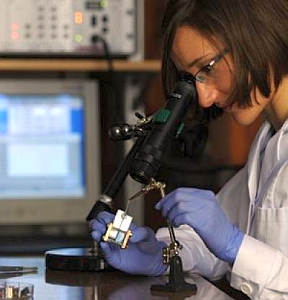
Adrianna Zloczewska works on zinc-oxygen biobattery. (Grzegorz Krzyzewski, Institute of Physical Chemistry)
Researchers at the Institute of Physical Chemistry in Warsaw, part of the Polish Academy of Sciences, developed a power source for implanted medical devices that works with the body’s chemistry, including oxygen taken from the from the air. The team working in the lab of the institute’s Marcin Opallo developed a prototype battery that powers a lamp with two LED bulbs.
Implanted medical devices require external power sources, but most common battery technologies that use strong acids and bases need to be completely sealed to prevent leakage. As a result, the battery housing can add significant weight and size to a medical implant. The need, therefore, is for a power source that can generate sufficient power over long periods of time, can be made small enough for an implanted device, and is safe for humans.
The team led by research associate Martin Jönsson-Niedziólka created a miniaturized zinc-oxygen battery that generates power with natural enzymes, carbon nanotubes, and silicates. Jönsson-Niedziólka notes that a popular science fair experiment is to generate electric power with a potato, harnessing the potato’s natural chemical actions. “We are doing something similar,’ says Jönsson-Niedziólka, “the difference is that we are focusing on biofuel cells and the improvement of the cathode.” He adds that in their project, they replaced the potato with a human.
The main component of the cathode in the institute’s biobattery is an enzyme surrounded by carbon nanotubes and contained in a porous silicate matrix deposited on an oxygen-permeable membrane. This electrode is installed in a wall of a small container, filled with an electrolyte solution containing hydrogen ions. The porous silicate matix lets in air, and the hydrogen ions interact with oxygen from the air plus the enzyme to generate electrons. The flow of electrons is transported by the carbon nanotubes from the surface of the membrane.
Ph.D. candidate and team colleague Adrianna Zloczewska (pictured at top) says earlier batteries made from bio-materials were based on glucose-oxygen biofuel cells, which at best generate between 0.6 and 0.7 volts. “A zinc-oxygen biobattery with our cathode,” says Zloczewska, “is able to generate 1.75 volts for many hours.”
The lab’s experiments show a battery cell with their biocathode can supply 1.6 volts for at least a week and a half. In addition, a cell of four batteries connected in series was able to power a two-bulb LED lamp. The researchers noticed, however, that the cell’s efficiency decreases with time, probably due to a gradual degradation of the enzyme on the biocathode. “The lifetime of a biofuel cell with our biocathode could be significantly prolonged,” notes Jönsson-Niedziólka, “if the enzyme regeneration processes are successfully developed.”
Read more:
- Heartbeat Vibrations Found Feasible to Power Pacemakers
- Renewable Power Storage, Management Modules in Development
- Scientists Produce Ultralight Carbon Nanotube Material
- Energy Institute Unveils Prototype Alternative Battery
- Robot Jellyfish Runs on Hydrogen, Oxygen in Water
* * *

 RSS - Posts
RSS - Posts
You must be logged in to post a comment.